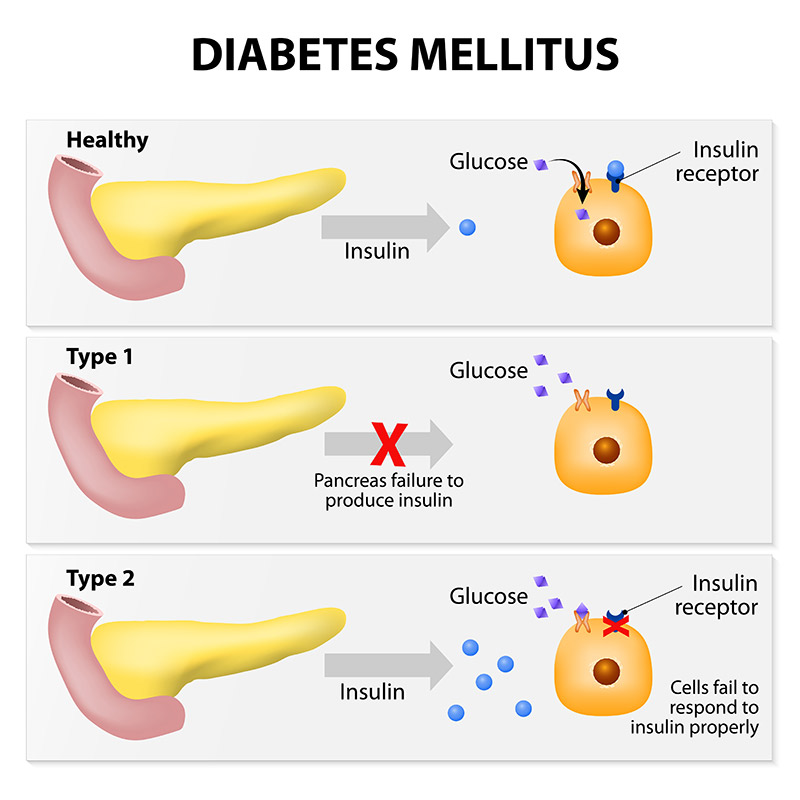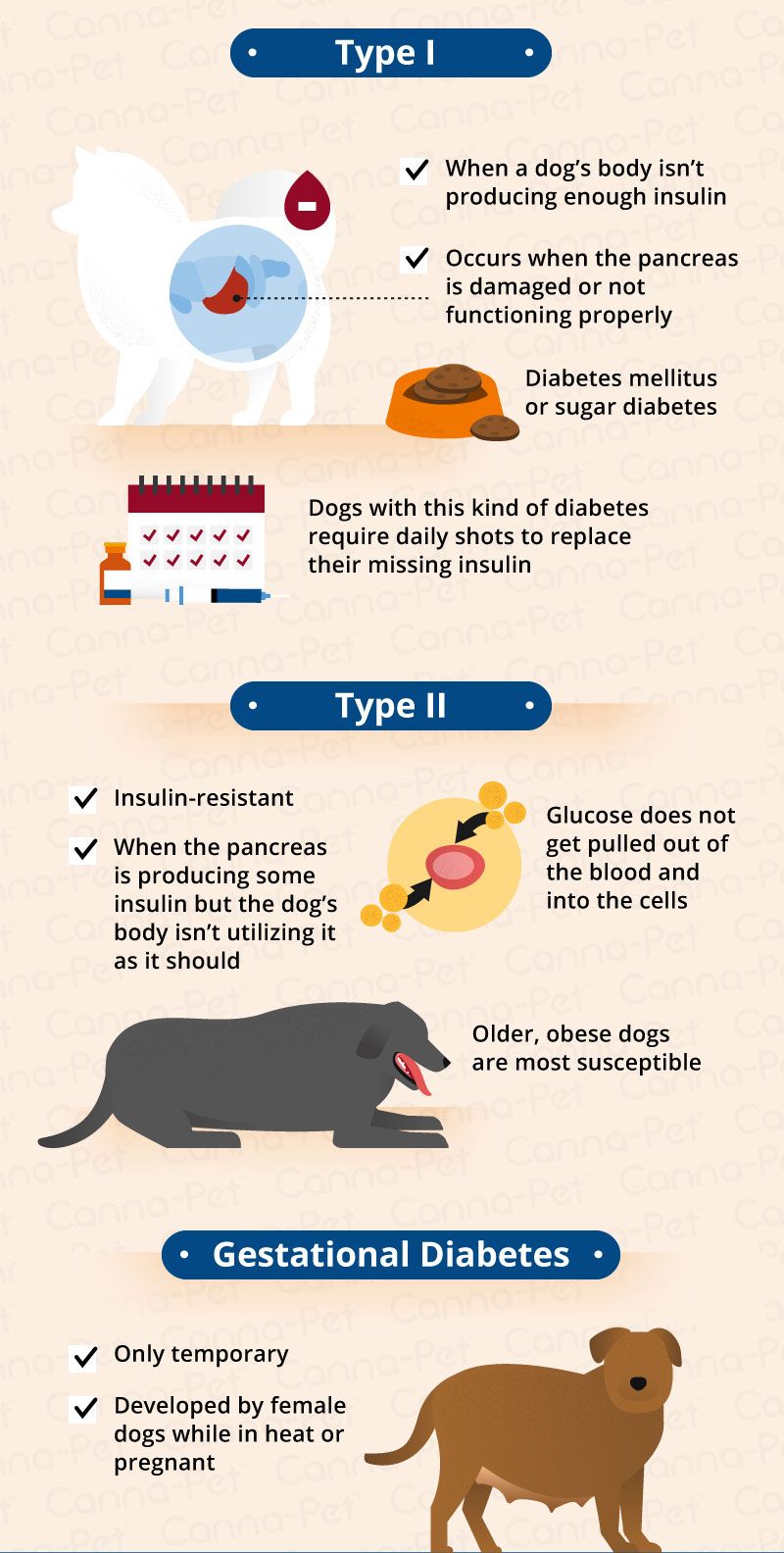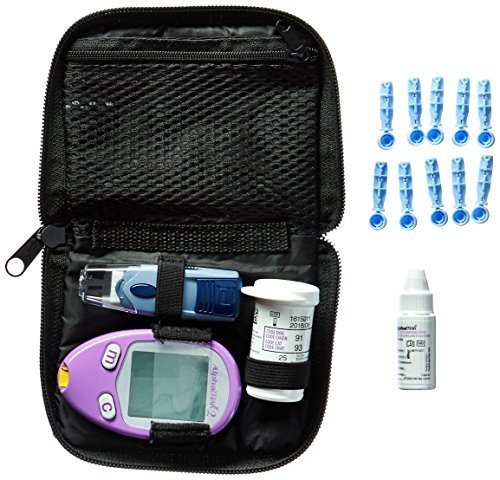Diabetes in dogs
What is diabetes in dogs?
Diabetes Mellitus (diabetes) in dogs is a relatively common chronic disease that can affect all dogs but is seen more often in middle-aged dogs of five years and older. The incidence increases with age. In rare cases it can also affect young puppies.
Diabetes in dogs is classified as Type 1 or Type 2, as it is for humans. Type 1 diabetes occurs when the dog has insufficient insulin, the hormone that regulates blood sugar levels. Type 2 diabetes occurs when the dog has an inadequate response to insulin. Type 1 is the more common disorder in dogs.
Diabetes is a metabolic disease. Metabolism is the process by which the body makes energy from food that has been eaten. Food is made up of proteins, carbohydrates and fats. The digestive system breaks the food down into sugars and acids, which are the body’s fuel. This fuel can be used immediately, or it can be stored in the cells for future use. A metabolic disorder occurs when this process is disrupted by abnormal chemical reactions in the body. A metabolic disorder can also develop when organs such as the liver and pancreas become diseased or cease to function normally.
Unfortunately, there is no cure for diabetes, but the disease can be effectively managed so that it doesn’t greatly impair the dog’s lifestyle. Successful management of diabetes can be achieved by means of insulin therapy and specially designed dog food. Untreated diabetes can cause complicated, life-threatening health problems for your dog.
What is glucose and how much is normal?
Glucose is a type of sugar that is found in carbohydrates. Glucose is essentially the fuel, or energy source, for the body’s cells and organs.
Glucose is absorbed from the intestines into the blood, which then transports it throughout the body. The normal level of glucose in the blood is 80-120 mg/dl (4.4-6.6 mmol/L) and it may rise to 250-300 mg/dl (13.6-16.5 mmol/L) following a large or high-calorie dog meal. However, if your dog suffers from diabetes, its blood glucose levels can rise above 400 mg/dl (22 mmol/L), a dangerous level that can cause seizures and long term damage if left untreated.
One of the main aims of diabetes treatment is to keep the glucose levels within a specific range. The key to achieving this is through monitoring blood glucose levels to better understand and balance the dog’s food intake, activity level and insulin injections.
What is insulin and why is it so important?
Insulin is an important hormone produced in the pancreas that controls the amount of glucose in the blood.
After a dog eats, the digestive system breaks down the food into various components, including glucose, which is carried into the dog’s cells by insulin. Insulin is effectively a chemical messenger that allows the cells to absorb glucose for energy and storage. Insulin helps in preventing blood sugar levels from getting too high or too low. Blood sugar levels that are too high is called hyperglycemia, and blood sugar levels that are too low is called hypoglycemia.
Without insulin, the body can’t regulate its blood sugar and transport glucose to the cells and organs of the body, where it is needed for energy or stored for future energy requirements. In the absence of insulin, the body’s fat and protein are broken down instead, resulting in muscle wasting and weight loss, despite the animal being ravenously hungry.
Types of diabetes in dogs

There are two diabetes classifications: Type 1 and Type 2.
Type 1 diabetes occurs where there is insufficient insulin production by the pancreas. The pancreas doesn’t produce any or enough insulin to properly regulate blood sugar levels in the dog, and external insulin injections are required for the dog to survive.
Type 2 diabetes occurs when insulin production is impaired, along with an inadequate response to the hormone. In this case, the pancreas is producing enough insulin, but the insulin is unable to take glucose from the bloodstream and into the cells.
Both types of diabetes require treatment. Over time, as the cells fail to respond to the produced insulin properly, the pancreas stops producing insulin.
There is a third type of diabetes, known as gestational diabetes, which is only temporary, occurring when the female dog is on heat or in season. Once she gives birth or is no longer in heat, the gestational diabetes disappears. This is not medically classified as type 1 or type 2 diabetes.

Source: https://canna-pet.com/diabetes-dogs-care-diabetic-dog/
Cost of diabetes in dogs*
Average claim cost |
Highest claim cost |
No of dogs affected in 2022 |
| $1,504 | $19,936 | 1,717 |
* PetSure claims data for diabetes experienced by dogs in 2022
Because it is difficult to predict the costs of veterinary care, it can help to have measures in place to help prepare for the unexpected. Pet insurance can help by covering a portion of the eligible vet bill if the unexpected does happen. Find out more about our pet insurance cover for dogs.
Symptoms of diabetes in dogs
If your dog shows any of these symptoms you should consult with your vet to determine if your dog is diabetic.
- Sudden change of appetite
- Ravenous appetite
- Vomiting after food intake
- Reoccurring urinary tract infections
- Sudden weight loss
- Lethargy
- Dehydration
- Increased water consumption
- Excessive thirst
- Excessive urination
- Cataract formation in the eye, possibly causing blindness
- Chronic skin infection
- Poor hair coat
Diagnosis of diabetes in dogs
The diagnosis of diabetes is based on clinical signs, physical examination and the detection of high levels of glucose in the blood stream and urine.
The vet can perform certain tests to check if your dog has diabetes. This entails testing for excessive glucose (sugar) in the dog’s blood and urine, because persistently high glucose levels are the hallmark of diabetes. Blood tests can also show other indicators of diabetes, such as high liver enzymes and electrolyte imbalances, in addition to high sugar levels.
The sooner the disorder is diagnosed by your vet and the sooner treatment starts, the less it will affect your dog’s life.
Causes of diabetes in dogs
The exact cause of diabetes is still unknown, however genetics, obesity, certain medications and abnormal protein deposits in the pancreas have been shown to play a role in the development of diabetes in dogs.
Diabetes can affect any dog, although overweight dogs are more prone to getting diabetes. Obesity and a high-fat diet are associated with the development of chronic pancreatitis, a condition that results in the progressive destruction of the pancreas, which is an implicating factor in diabetes. Additionally, overweight dogs who have diabetes are more difficult to manage and treat, so your vet will recommend that your dog loose weight if the animal is overweight or obese.
Dogs with hyperadrenocorticism, or Cushing’s disease, a disorder of excessive glucocorticoid secretion in the body, are at greater risk of developing concurrent diabetes. This is because the excess cortisol results in increased glucose in the blood and insulin resistance in the body.
Some research has shown that certain breeds are more predisposed to diabetes than others, suggesting that genetics plays a role in some breeds. Some of the breeds with a higher incidence of the disease are Beagles, Dachshunds, Golden Retrievers, Pinscher, Labradors, Westland Highland Terrier and Tibetan Spaniel Terriers.
It is recommended to neuter female diabetic dogs as the disease can cause complications when the female is in heat. The hormones that are released during the oestrus period can have a negative impact on the illness, resulting possibly resulting in complications.
Treatment for diabetes in dogs
Treatment for diabetes in dogs is life-long as remission does not occur. Treatment consists of two components, the first being regular and adequate insulin intake and the second being diet. The two go hand in hand.
Insulin
Life-long insulin injections, either daily or twice-daily, will be required for a diabetic dog. Through glucose sugar monitoring, the vet will establish the correct amount of insulin you need to give your dog each day.
Diet
It is very beneficial for diabetic dogs to have a good diet and a lean body composition. Your vet will recommend a suitable diet, which might change over time, depending on your dog’s activity levels in its senior years.
Diet plays a very important role in the treatment and adjustment of insulin levels; the days of giving your dog food scraps from your dinner table are unfortunately over. Controlling the carbohydrate intake in your dog’s diet will stabilise the insulin levels. There are specifically designed low carbohydrate dog foods for diabetic dogs that release glucose into the dog’s bloodstream much more slowly than normal dog food. Your vet will most likely prescribe one of these special low carbohydrate dog foods.
Consistent feeding times and quantities of food are crucial; any change in food intake can affect the insulin levels your dog requires. Please speak to your vet if you wish to change foods or increase or decrease the intake, as this will affect the treatment plan. Once your dog’s insulin intake and diet are well established, the maintenance costs aren’t excessively high. However, the diagnosis and establishing the treatment plan can be costly.
Exercise
Let’s not forget that exercise also plays an important role for diabetic dogs. A healthy lifestyle with plenty of exercise will help to prevent weight gain, and a leaner dog is ultimately a healthier and happier dog.
What happens if you don’t treat diabetes?
When diabetes in dogs remains untreated, the dog will develop secondary problems with potentially devastating effects on the animal’s body.
The effects of untreated diabetes can include:
- Cataracts (leading to blindness)
- Enlarged liver
- Urinary tract infections
- Seizures
- Kidney failure
- Constant lethargy
- Ketoacidosis, a potentially life-threatening acute condition that can be accompanied by rapid breathing, dehydration, lethargy, vomiting, or sweet-smelling breath. It can be triggered by factors such as stress, post-surgery, long periods of fasting, infection in the body or an underlying, untreated health condition combined with low insulin levels. If you are the owner of a diabetic dog you should always have a ketone testing stick with you so that you can test your dog’s urine, if your dog shows any of the above signs. If this test is positive, please visit your vet immediately.
Management and monitoring of diabetes in dogs
Although some cases may be more challenging than others, most occurrences of dog diabetes can be managed successfully and without complications. You, the owner, will play a vital part in monitoring glucose levels and injecting your dog with insulin.
Your veterinarian will work with you to determine the best management plan for your dog. From diagnosis to implementing the treatment plan, frequent visits to the vet will be necessary in order to adjust medication and to get the combination of diet, insulin dosage and home monitoring right. In addition, life-long glucose monitoring is required for all dogs with diabetes and regular blood and urine tests are needed for long-term management.
Your vet guide you through learning the ropes on living with a diabetic dog and provide advice and instruction on the following important topics:
- When to measure glucose levels
- How to use an in-home glucose-monitoring system
- Insulin medication and how to administer it
- Strict diet plan and exercise recommendations
- Warning signals to look out for when your dog might have a diabetic emergency and require a visit to the vet
Collecting and testing of blood samples to check glucose levels
Your vet will recommend a glucose home monitoring kit and show you how to collect and test blood samples.
Generally, blood is collected from the hairless part of the dog’s earflap. It is recommended that you warm up your dog’s ear by holding it in between your hands until warm; by doing so, it is easier to collect blood and more comfortable for the dog. Once your dog’s ear is warmed up, use a clean prick needle from the monitoring kit to prick into the hairless part of the ear. A small drop of blood will appear. Quickly collect the drop of blood onto the glucose test strip from your kit. Depending on the type of home-monitoring kit, you will either insert the test strip into the home reader to read the results, or the test strip itself will tell you the results.
Press some clean cotton wool onto your dog’s ear to absorb any remaining blood and to stop the bleeding and potential bruising.

ALPHATRAK® 2 BLOOD GLUCOSE MONITOR FOR DIABETIC CATS & DOGS
Source: https://www.zoetisus.com/products/dogs/alphatrakmeter/alphatrak-home.aspx
When should you test your dog’s glucose levels?
When and how often should you test your dog’s glucose levels depends on each individual dog, taking into account the type of diabetes, the treatment protocol and the insulin being used. Your vet should give you guidelines on when to test, which may be :
- Before breakfast or dinner
- Before bed
- After a meal
- When you think your dog is feeling unwell
- After some exercise
What should you do if your dog has a diabetic emergency?
Diabetic emergency situations include the following situations:
- You test glucose levels and they are extremely low. This is an indication of low blood sugar, also known as hypoglycaemia.
- You test glucose levels and they are extremely high, remaining above normal even after giving insulin. This is an indication of high blood sugar, also known as hyperglycaemia.
If either of these occurs, please contact your veterinarian immediately, as your dog might require an insulin adjustment or treatment for other medical problems that might arise during the diabetic emergency.
Here a few warning signals to look out for:
- Excessive drinking
- Sudden reduction or loss of appetite
- Frequent urination – can’t hold urine
- Constipation, diarrhoea or vomiting
- Sudden unusual behaviour change
- Muscle twitching, seizures
- Depressed
- Blood in urine
- Swelling of neck or head
- Ketoacidosis
In summary
The diagnosis of diabetes can be a big shock to most dog owners and to the prospect of measuring blood levels and administering insulin injections can be daunting. However, once the dog’s insulin levels are adjusted and the condition stabilises, a familiar routine will develop and the process becomes easier. With early detection and proper treatment and management, many dogs with diabetes go on to live long, happy and healthy lives.
Bow Wow Meow Pet Insurance can help protect you and your dog should an unexpected trip to the vet occur.
- Find out more about our dog insurance options
- Get an instant online pet insurance quote











